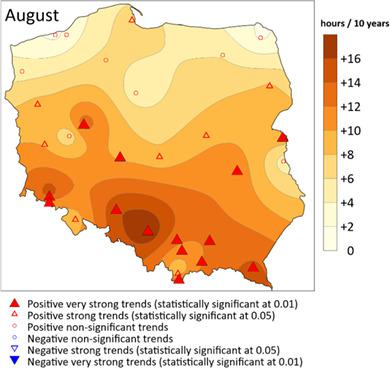当前位置:
X-MOL 学术
›
Int. J. Climatol.
›
论文详情
Our official English website, www.x-mol.net, welcomes your feedback! (Note: you will need to create a separate account there.)
Trends in sunshine duration in Poland (1971–2018)
International Journal of Climatology ( IF 3.9 ) Pub Date : 2020-04-19 , DOI: 10.1002/joc.6609 Krzysztof Bartoszek 1 , Dorota Matuszko 2 , Stanisław Węglarczyk 3
International Journal of Climatology ( IF 3.9 ) Pub Date : 2020-04-19 , DOI: 10.1002/joc.6609 Krzysztof Bartoszek 1 , Dorota Matuszko 2 , Stanisław Węglarczyk 3
Affiliation

|
This study aims to characterize temporal and spatial trends of sunshine duration in Poland based on data from the years 1971–2018 and to make an attempt to explain their causes. Daily sunshine duration came from 31 Polish meteorological stations. Data from 10 stations came only from a traditional Campbell–Stokes heliograph, while in the other 21 synoptic stations Campbell–Stokes heliograph was replaced with an automatic sensor in 2014 and since then only such data are available. The smallest sunshine duration occurs in December (average areal total—39.7 hr), and the highest in July (average areal total—230.1 hr). The spatial distribution of sunshine duration in Poland shows great diversity associated with different day lengths depending on latitude. In the cool part of the year (November, December, January, and February) the isolines of totals of sunshine duration run from the highest values in the south to the lowest in the north of the country, while in the months of the warm part of the year (March to September) the system is reversed. The multi‐annual trends in sunshine duration in Poland are similar to the changes taking place in other parts of the world. The years 1971–1980 mark the end of “global dimming,” which was manifested in very low values of actual and relative sunshine duration. “Global brightening” confirms a statistically significant growing trend in sunshine duration at all the analysed meteorological stations in Poland from April to September. There is a strong statistically significant relationship between the areal totals of sunshine duration and the type of pressure system, average monthly cloud cover, and atmospheric optical depth.
中文翻译:

波兰日照时间的趋势(1971–2018)
这项研究旨在根据1971-2018年的数据来表征波兰日照时间的时空趋势,并试图解释其原因。每天的日照时间来自31个波兰气象站。2014年,来自10个气象站的数据仅来自传统的Campbell-Stokes Heliograph,而在其他21个天气观测站,Campbell-Stokes Heliograph被自动传感器取代,此后仅提供此类数据。最小的日照时间发生在12月(平均总时间39.7小时),最高的是7月(平均总时间230.1小时)。波兰日照时数的空间分布显示出极大的多样性,取决于纬度,日长不同。在一年中最凉爽的部分(11月,12月,1月,和2月)的总日照时间等值线从该国南部的最高值到该国北部的最低值,而在一年中最暖和的月份(3月至9月),该系统则相反。波兰日照时间的多年趋势与世界其他地区的变化相似。1971–1980年标志着“全球变暗”的终结,这以实际和相对日照持续时间的极低值体现出来。“全球增亮”证实了4月至9月波兰所有分析的气象站的日照持续时间具有统计上的显着增长趋势。在日照时长的总面积与压力系统类型,平均每月云量,
更新日期:2020-04-19
中文翻译:

波兰日照时间的趋势(1971–2018)
这项研究旨在根据1971-2018年的数据来表征波兰日照时间的时空趋势,并试图解释其原因。每天的日照时间来自31个波兰气象站。2014年,来自10个气象站的数据仅来自传统的Campbell-Stokes Heliograph,而在其他21个天气观测站,Campbell-Stokes Heliograph被自动传感器取代,此后仅提供此类数据。最小的日照时间发生在12月(平均总时间39.7小时),最高的是7月(平均总时间230.1小时)。波兰日照时数的空间分布显示出极大的多样性,取决于纬度,日长不同。在一年中最凉爽的部分(11月,12月,1月,和2月)的总日照时间等值线从该国南部的最高值到该国北部的最低值,而在一年中最暖和的月份(3月至9月),该系统则相反。波兰日照时间的多年趋势与世界其他地区的变化相似。1971–1980年标志着“全球变暗”的终结,这以实际和相对日照持续时间的极低值体现出来。“全球增亮”证实了4月至9月波兰所有分析的气象站的日照持续时间具有统计上的显着增长趋势。在日照时长的总面积与压力系统类型,平均每月云量,


























 京公网安备 11010802027423号
京公网安备 11010802027423号